Ring Nebula (Messier 57)
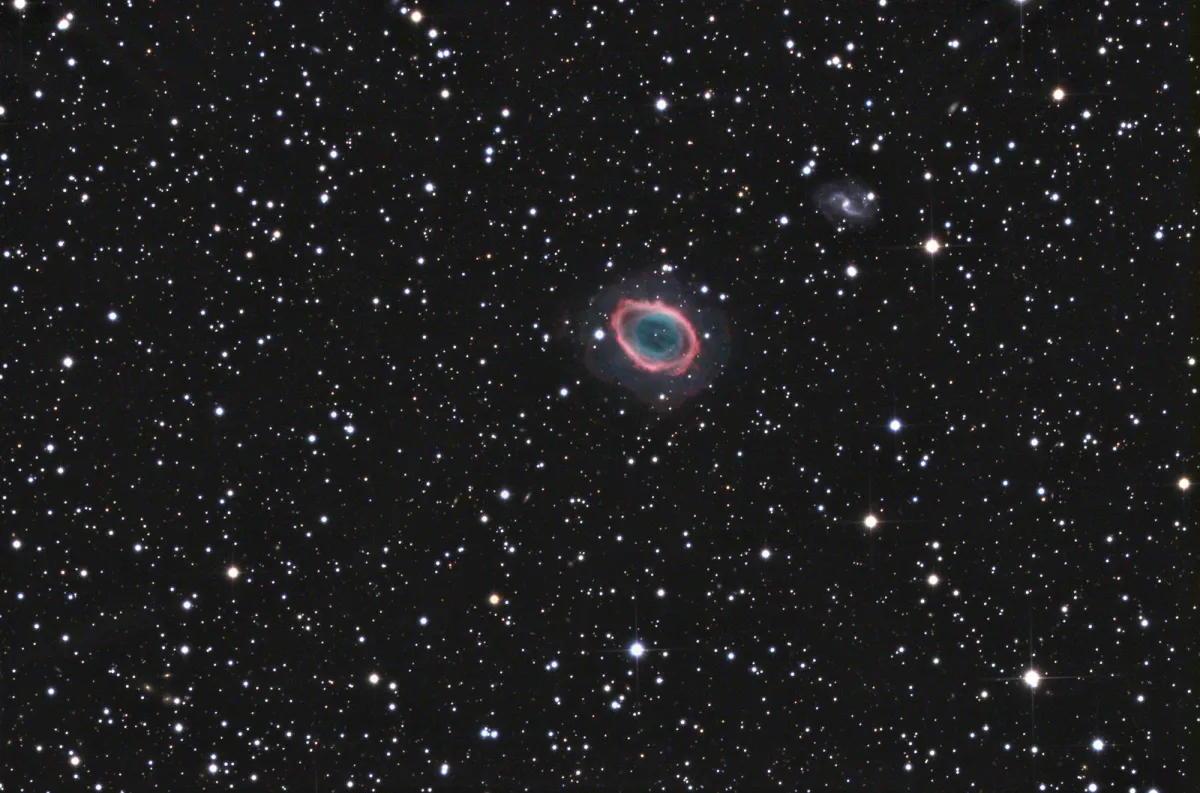
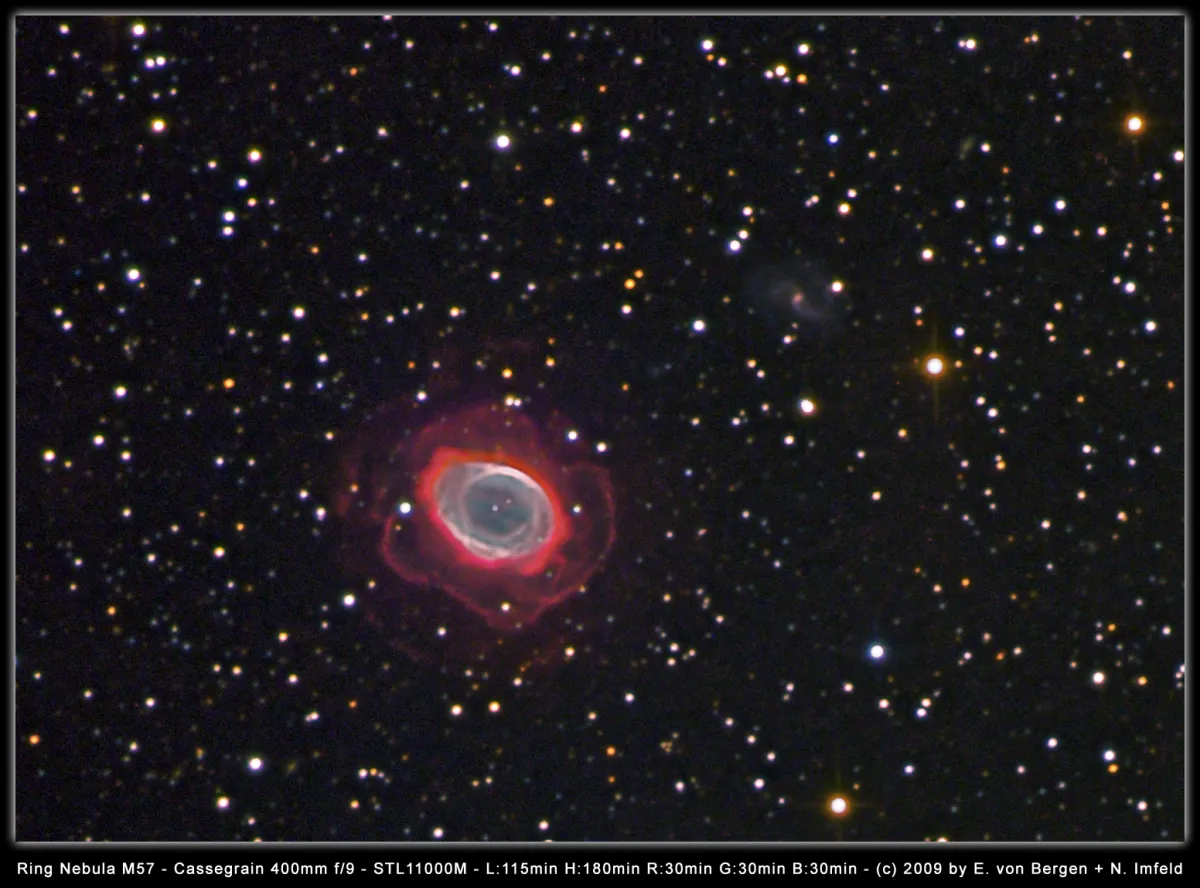
History
Messier's number 57 is arguably the most famous planetary nebula. It was discovered in 1779 by the French astronomer Antoine Darquier of Toulouse and a short time later on 31 January 1779 by Charles Messier. He wrote: «Light clusters between γ and β Lyrae, discovered during the observation of the comet of 1779, which passed very close: it seems that this round light cluster consists of very small stars: with the best telescope it is not possible to find them to see, there remains only the suspicion that they exist. M. Messier reported about this cluster of light on the map of the comet from 1779. M. Darquier from Toulouse discovered this nebula while observing the same comet and reports: «Nebula between γ and β Lyrae. It is very uniform but sharply defined and as big as Jupiter and looks like a planet that has expanded» [281]
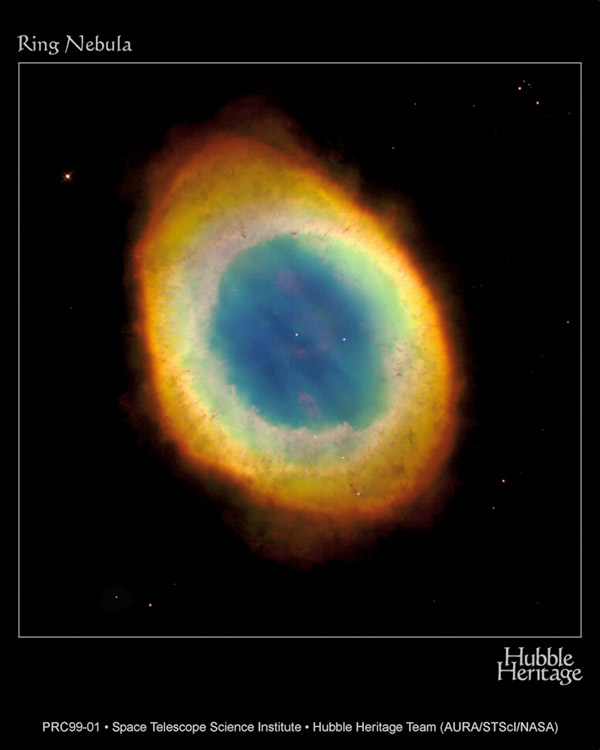
Physical Properties
The light-colored ring of M 57, which some call a donut or smoke ring, has the dimensions 80x60 arc seconds. Long-exposure photographs show that this ring is still surrounded by a weak outer shell, 170 arc seconds in diameter, which resembles a wreath of flowers (Fig. 2). Faint, parallel stripes cross the ring.
The ring shape of M 57 is actually neither a ring, nor a torus, nor a semi-transparent hollow bubble, but rather a projection of a more complicated bipolar structure due to the direction in which we are looking. Using a spectrometer of the 2.5 m Isaac Newton telescope on the Canary Islands, two clearly separated expanding gas flaps of M 57 could be distinguished. One points exactly in our direction, the other away from us.
This structure is believed to have arisen because a sun-like star had used up all of its hydrogen and expanded into a red giant. The outer layers gradually drifted off as a result of the stellar wind. The stellar wind is more concentrated in the equatorial region and thus caused the formation of a gas disk, which we see as a weak halo around M 57. Later the star experienced gusts of stellar winds, which blew away the rest of the outer atmosphere. However, since material was already present in the equatorial plane of the star, this gas escaped mainly along the axis of rotation and thus formed the two polar gas lobes (Fig. 4). However, we do not see anything of this bipolar form, since we are looking exactly perpendicular to the equatorial plane of the central star. [108]
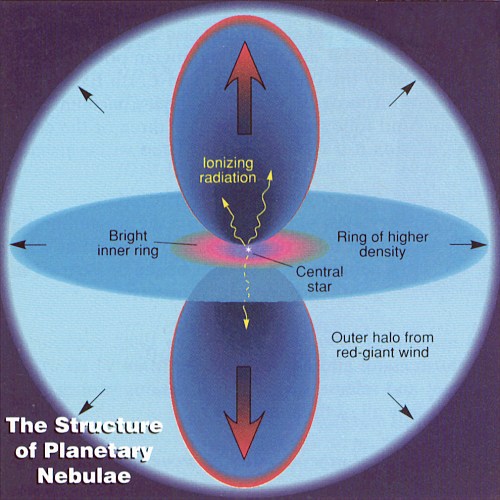
It is assumed that the central star of M 57 is variable, because different measurements and observations at different times resulted in contradicting values from 14.2 to over 16 magnitudes - but this may be due to the fact that the star is covered by a thin layer of gas and thus his Visibility similar to that depending on the atmospheric conditions on earth. The central star is a bluish dwarf or sub-dwarf star with a seemingly continuous spectrum. The protected surface temperature is 120'000 K and the calculated density should be a thousand times higher than that of the sun. Stars of this type produce strong ultraviolet radiation, which causes the bright fluorescence of the thin gases in the nebula. The typical bluish-greenish color of this nebula is mainly caused by the two strong emission lines (500.7 nm and 495.9 nm) of doubly ionized oxygen. The color of the ring nebula runs through all rainbow colors from blue to red from the inside to the outside. The central region only appears so dark because of the contrast of the light ring. The colors in Fig. 3 largely correspond to the natural ones. The emissions of very hot helium near the central star are coded in blue, the light from ionized oxygen a little further away appears green and the coolest gas shows ionized nitrogen glowing red. The color changes show how the gas glows, which is excited by strong UV radiation from the central star. [4, 176]
The distance from M 57 is estimated to be about 2000 light years. [176] According to this information, the brightest part of the nebula should have a diameter of about 50'000 AU. Spectroscopic studies have shown that the nebula expands at a speed of around 19 km/s. [4]
| Designations | PN G063.1+13.9: NGC 6720, PK 63+13.1, ARO 9, M 57, VV 214, VV' 466 |
| Right Ascension (J2000.0) | 18h 53m 36s |
| Declination (J2000.0) | +33° 01' 40" |
| Dimensions | 76." (optical) |
| Distance | 0.50 kpc |
| Radial Velocity | -19.2 ± 0.7 km/s |
| Expansion Velocity | 26.5 (O-III) km/s |
| C-Star Designations | AG82 333, CSI +32 -18517, HD 175353, PLX 4377 |
| C-Star Magnitude | B: 15.03, V: 15.29 |
| C-Star Spectral Type | O(H) |
| Discoverer | MESSIER et al 1779 |
Galaxy IC 1296
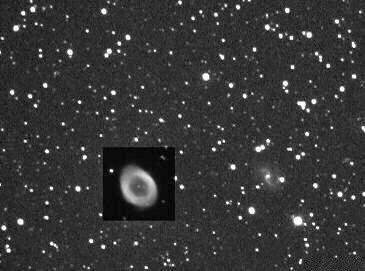
The galaxy IC 1296 is searched in vain in the Uranometria or Burnham's Celestial Handbook, which is why the information on it is only sparse - it is only 4 arc minutes away from M 57. With a visual brightness of 14.83 mag and the dimensions 66x48 arc seconds, this galaxy is still just within the visible range for amateur telescopes. The position angle of the axis of rotation of this galaxy is 80.0°. The Lyon-Meudon Extragalactic Database [134] gives an inclination of the axis of rotation of 43 degrees to our line of sight. There you can also find a surface brightness of 15.35 mag. The escape speed is around 5100 km/s. [145]
| Designation | IC 1296 |
| Type | Gx (SBbc) |
| Right Ascension (J2000.0) | 18h 53m 18.8s |
| Declination (J2000.0) | +33° 03' 59" |
| Diameter | 1.1 × 0.8 arcmin |
| Photographic (blue) magnitude | 14.8 mag |
| Visual magnitude | 14.0 mag |
| Surface brightness | 13.7 mag·arcmin-2 |
| Position Angle | 80° |
| Redshift (z) | 0.017075 |
| Distance derived from z | 72.12 Mpc |
| Dreyer Description | eF, pS, iR, 4' np M 57 |
| Identification, Remarks | UGC 11374, MCG 6-41-22, CGCG 201-40, near M 57 |
How to find the Ring Nebula?
The planetary nebula M 57 is located in the constellation Lyra and is very easy to find. It lies almost exactly on the line connecting the two southern stars Sheilak (β Lyrae) and Sulafat (γ Lyrae) of the parallelogram in the lyre, a little closer to the western star Sheilak. The best way to find it is to use an eyepiece that provides at least half a degree of field of view. The galaxy IC 1296 is only four arc minutes in the direction of 2 o'clock and is therefore visible in the same field of view. The best observation time is April to October.
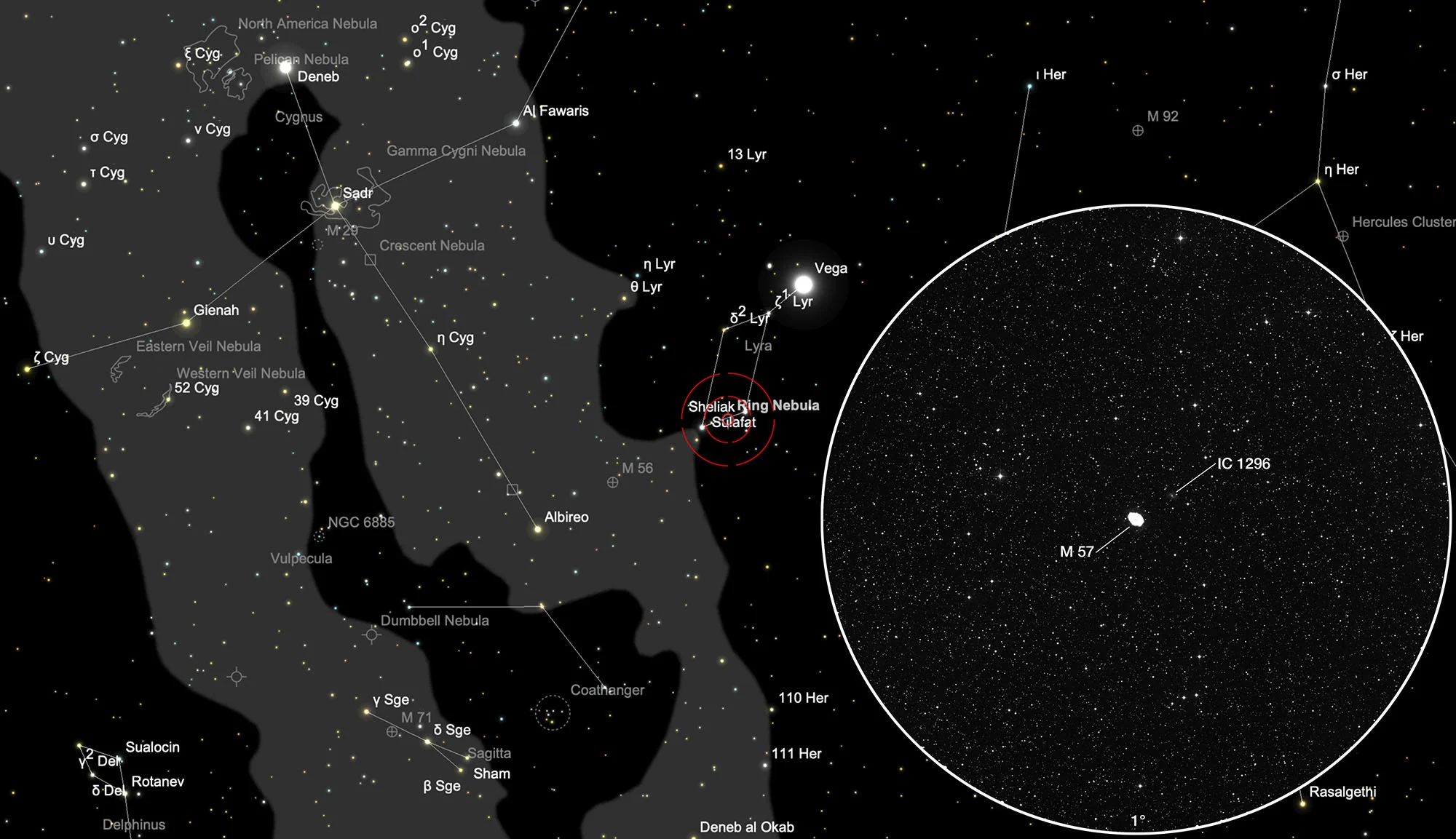
Visual Observation
In smaller telescopes you can see a disc or can just make out the ring. The planetary nebula M 57 appears in somewhat larger instruments as a bright oval ring, which is also filled with a fine veil of nebula on the inside.
For many, the M 57 Ring Nebula poses another challenge, namely seeing the central star. The central star, bright or dark with 15.3, likes to set in the inner nebula. Only really good seeing, i.e. calm air and a good view, bring the central star to light. With an opening of 14 arc seconds the central star is within easy reach. In calm air and a view of 6.2 mag I was able to hold the central star at high magnification, ie over 400x longer. In earlier observations with a 12.5 arc seconds Dobsonian, the central star flashed each briefly on. Whereby calm air is to be mentioned as the most important requirement, otherwise the central star smears and merges with the inner fine nebula.
In summary - the ring nebula is an interesting object for smaller and larger telescopes. To see the ring shape with small instruments or to see the central star with larger telescopes represent the respective challenges. [192]
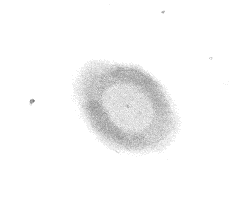
300 mm Aperture:The ring shape of M 57 is clearly recognizable from a small magnification of 26 times. It then looks like a tiny, almost perfectly circular shape of smoke. With increasing magnification, it becomes apparent that the ring is actually elongated in the northeast / southwest direction, in a roughly 5 to 6 ratio. At 300 times the magnification, clear differences in brightness can be seen in the ring. At the ends of the longer axis, the ring appears darker and frayed, while it is longer at the northeast end. The inner surface of the ring is clearly brighter than the sky background. The central star of M 57 can barely be guessed at with indirect vision and hyperventilating in a rather brighter and wetter night. In order to be able to recognize him safely, a clear and dark night is necessary, as it is seldom. An O-III filter brings only a minimal improvement in contrast and an H-beta filter makes M 57 almost disappear. — 300mm f/4 Popp Newton, 1996, Bernd Nies